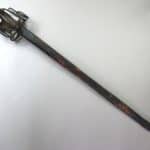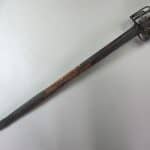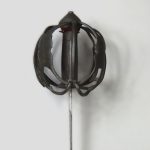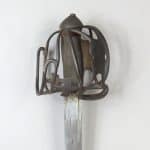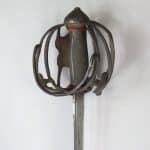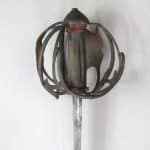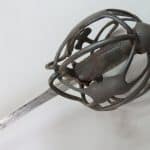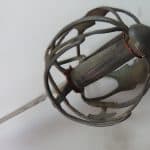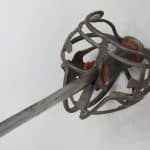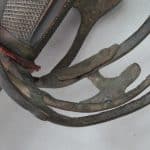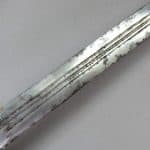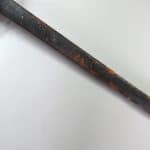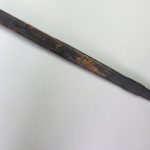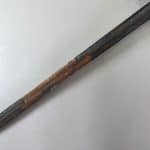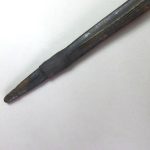
A Scottish Basket Hilted Sword dating to the second quarter of the 17th century
To enquire about this itemplease click here
Price: £3,400
Ref: 52041601
Item Description
A scarce Scottish basket hilted sword of early form mounted with a double edged blade. This is a noteworthy representation of its type in original condition. It is best described as an “attic find” having obviously been locked away somewhere for a very long time. It has a rusted russet patination to the hilt and unusually has never been restored or overly cleaned. The sword retains its scabbard which is of scarce early form now damaged and repaired.
This sword form evolved in the early part of the 17th century and was used by Scots through to the English Civil War periods. It is the ancestor of the fully developed Scottish basket hilted swords of the later 17th and 18th centuries. Early 17th century English sources refer to this sword type as “Irish” due to its evolution in the Gaelic speaking culturally separate regions of Highland Scotland and Ireland whose people and language were generally grouped as “Irish” by English commentators. The English adopted this template of sword and developed it further along slightly different “English” lines during the 17th century.
The hilt has rectangular frontal guard plates engraved with pairs of parallel lines. Notches are cut into the sides of each plate marking the beginning of the trend of Scottish sword makers to file frets and merlons into the edges of guard plates which became more complex and decorative on later swords as guard plates became larger. In fact the guard plates on this hilt are larger than those on many others of the type showing that this sword is in transition to later basket guard styles and is a rare example.
The dome-shaped pommel has a groove chiselled around its circumference just below its middle to secure the guard arm terminals. The pommel has a flattened circular button on top. Line decoration is applied towards the pommel rim. Flattened butterfly shaped merlon bars are applied at the sides strengthen the hilt structure by joining the main guard bars.
The baluster shaped wooden grip is diamond fretted with lined iron ferrules top and bottom and the remnants of a red cloth liner at each end.
The original scabbard is of scarce early form made from hollowed slats of wood covered with leather stitched along the middle on one side. It lacks its iron furniture apart from the crimped iron chape. It is in poor condition with the wooden core exposed and broken in the middle. The scabbard appears to have been snapped or at least damaged towards the chape and now repaired.
The scabbard is stitched along the middle of the inner side and retains its two scalloped iron suspension mounts on the outer side which are of early form. The scabbard tip has been reinforced at its join with the chape. The scabbard retains remnants of its original lined decoration.
The double-edged blade is of lenticular section and gently tapers to its tip. It has a pronounced ricasso extending for just under 2 inches (4.5 cm) from the hilt with a pronounced fuller inside each blunt edge. From the end of the ricasso three fullers extend for 7.5 inches along the middle stamped with “ANDRIA” in the middle fuller on one side and “FERARA” in the middle fuller on the reverse side with patterns of crosses to the sides and in the fullers above and below. Beyond the fullers on one side is a group of small orb and cross marks. The shoulders of the ricasso fit into a shallow rectangular shaped aperture purposely cut to secure the blade underneath the cross hilt.
The hilt resembles the basket guards of a number of Scottish swords illustrated in Cyril Mazansky’s “British Basket-Hilted Swords” (Boydell Press 2005), and in particular references D9, D10, D10a and D10b on pages 80 to 82. These swords have similar hilt structures and engraved line patterns to the frontal guard panels. These swords are housed in various important collections including Blair Castle in Perthshire, the Marischall Museum in Aberdeen, and The Royal Armouries. Two further similar swords housed in the National Museums of Scotland, are illustrated in John Wallace, Scottish Swords & Dirks, 1970, Arms and Armour Press, figs 23 and 25.
For a further examination of this sword type see: Stuart C Mowbray, “British Military Swords”, Mowbray Publishers, 2013, section 10 entitled “The So-Called Irish Hilt Sword, pages 110 to 126, for examples similar to our sword and English variants, particularly that shown on pages 114 and 115.
The blade is 30.75 inches (78 cm) long and the overall length of the sword is 36 inches (99.5 cm).
The sword hilt is in russet condition. One guard bar has cracked at its join with the top of the knuckle bow. One of the lateral bars extending out from the cross bar is broken. There is a working life riveted repair to the inside of one of the side guard bars. The blade has been protected by the scabbard and is in fine condition with minor shallow patches of blackened age.
